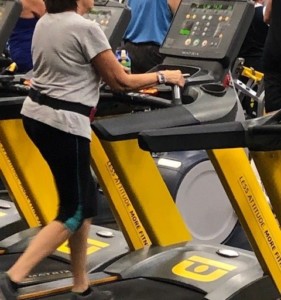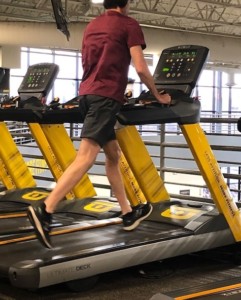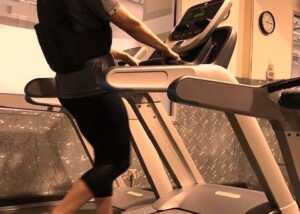
No matter your age, you’re doing yourself NO favor if you hold onto the treadmill’s front bar when walking.
As a personal trainer, I require all of my clients, including older, poorly conditioned ones, to avoid—yes, avoid—holding onto the treadmill as they do their walking.
Now if they need to hold on for some momentary steadying or to drink some water, that’s fine.
But what I’m referring to here is holding onto the treadmill throughout the duration of the walking session.
The woman pictured above exemplifies a very prevalent scenario in any gym, health club or recreation center where there are treadmills.
The phenomenon of holding on spans all age groups, not just older individuals.
Look at the lady in the photo. Does that appear to be an efficient way to improve one’s walking fitness, aerobic fitness or any kind of fitness?
Why does holding the front bar of a treadmill sabotage the walking workout?
Because natural walking involves a particular movement of the upper body that coordinates with the lower body.
Holding onto the front bar disconnects the upper body with the lower half; it immobilizes it, locks it up.

The hips, then, are forced to over-rotate, especially if the tread is set to a fast speed such as 4 mph.
When you’re holding on, “you are going to create more torque of the pelvis which isn’t good for you, says Joel Silbar, a chiropractic physician.
It’s painful just to watch someone’s hips going as they “walk” at 4 mph while clinging to the front bar.
But even if you walk slowly, you’re still getting no bang for your buck, because this fails to mimic actual walking.
Walking on a treadmill without holding on actually has a carryover to real-world walking, even though the ground or floor you walk on isn’t moving under your feet. People train for walk-a-thons by walking (hands off) on a treadmill.
In cold weather I use a high incline to mimic outdoor hikes and trail runs, and believe me, it transfers over because I don’t hold on.
In short, don’t underestimate the effectiveness of a treadmill (hands off) for improving your body’s cardiovascular fitness, knee joint integrity and other elements.
The man in the photo at the top is walking for the photographer, but his position on the treadmill, hands on the front bar, is identical to what you’ll see in every facility that has these machines. People just love to cling onto the front bar.
Even a light hold sabotages the session. Holding onto the front bar mimics using a walker.
For tall people, it makes them hunch forward, which is bad for the spinal column.
Shorter people tend to yank to and fro with each step. Medium height people don’t get off the hook, either; holding fast to the front bar (or lightly) still sours their natural gait.
Holding on anywhere on the machine significantly reduces calories burned.
The calorie display shows the same number whether you’re a man, woman, old, young, skinny, huge, Martian, Vulcan … because the display is determined by the speed of the tread and the incline, NOT the person on the tread. It also removes work from the core, transferring it to the arms! It teaches you how to walk inefficiently, not efficiently.
How to Break Free from Holding onto the Treadmill’s Front Bar
Simply let go, assuming that the machine’s settings are already reasonable. I tell people to “just let go.” They do, and guess what: They don’t fall off. Instead, their posture instantly improves.
They feel more muscles becoming engaged. If someone has the settings crazy high, such as a 15 percent incline and 4 mph, I point out that this is a very unrealistic setting to sustain a walk for, and to knock down the incline or the speed, e.g., if you want to go 4 mph, then bring down the incline to just five percent.
If your low back begins hurting after you’ve let go of the treadmill, this is because all that holding on has de-conditioned your low back, which is supposed to be engaged when you walk.
The solution is to just keep walking WITHOUT holding on to give your low back a chance to catch up and get stronger. The aching will disappear soon enough.
Lorra Garrick is a former personal trainer certified through the American Council on Exercise. At Bally Total Fitness she trained women and men of all ages for fat loss, muscle building, fitness and improved health.
.

























